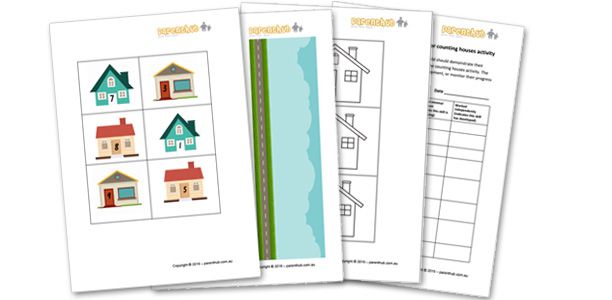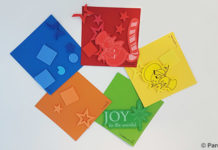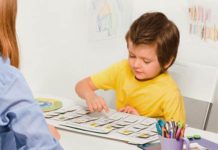Age
3-6 years
Duration of activity
15 minutes to 1 hour depending on if only the original activity or also the extension activities are completed.
Materials/equipment
- Downloadable Counting and Ordering Houses Worksheet.
- Child-safe scissors
- Glue stick
- Sticky tape
- Numeral and dot flashcards if your child is still learning to recognise numerals and relate them to the corresponding quantities.
- Optional: laminate to re-use this activity: laminate the Downloadable Counting and Ordering Houses Worksheet, cut out houses and place a small ball of blu-tac on the back of each house, so the child can stick the houses to the road. Skip step 4 in the instructions below. See images below for creating activity for re-use.
- Downloadable development assessment table, if you wish to monitor your child’s progress.
- Optional: Extension activity downloadable and extension development assessment table.
Cost
The cost of this activity is negligible. Apart from printing the worksheets, you’ll probably have all the materials you need to do this activity around the house.
Preparation
 Gather all the materials you’ll need and prepare an area for your child to work. Pasting can be a messy activity for 3-4 year olds, so you may wish to cover the table with a large plastic placemat or something similar to make cleaning up a bit easier.
Gather all the materials you’ll need and prepare an area for your child to work. Pasting can be a messy activity for 3-4 year olds, so you may wish to cover the table with a large plastic placemat or something similar to make cleaning up a bit easier.- If you are laminating your worksheet to re-use, do this now.
- If you are not going to be laminating, fold over the edges of the ‘road’ worksheet and sticky paste the sheets together to make a long continuous road. See image to right.
- If your child is still in the very early stages of recognising numerals, ask your child to place the number and dot flash cards in order from smallest to largest. You can help them if they struggle.
Instructions: How to do this activity
 1. Explain why knowing your numbers and how to order them is important
1. Explain why knowing your numbers and how to order them is important
- Begin by explaining to your child that they will be doing an activity that helps them learn to recognise numerals and the correct order of numbers.
- Talk about what numbers represent (quantities), why houses have numbers and why house numbers need to be in the correct order (e.g. so that the postman or visitors can easily find the right house, because they know where in the sequence it occurs).
- Talking to your child about the numbers will help them understand the role and importance of numbers in our everyday lives.
2. Show your child the activity sheet with the unordered houses and explain why this is a problem
- Next show your child the activity sheet and explain that although every house has a number they are out of order, so a person that wanted to visit their friend in house number 7, might have difficulty finding their house.
- Point to each house on the activity sheet and ask your child to tell what number the house is, by reading the numeral. If your child is still learning to recognise numerals, have a set of Numeral and quantity flashcards on hand. When they get stuck, ask them to look at the flash cards and find the card with the same numeral. Then ask them to count the quantity of dots on the flash card, so that they can identify the numeral (the last number that they count). Do this for every numeral that they do not recognise.
3. Discuss similarities and differences between the houses
- Talk about how some of the houses are the same and some are different. Talk about the features that make them the same and different (i.e. the shape and colour of the houses).
4. Cutting the houses
- Now ask your child to cut out the houses so that they can put them in order.
- Remind them to use their scissors safely, for example not to get up and walk around while they are holding a pair of scissors.
- Remind them how to use scissors with thumb and index finger and how it is easier when you turn the page as you cut.
 5. Identify and paste the houses in order
5. Identify and paste the houses in order
- Now ask your child to identify the house that comes first (i.e. the house with numeral 1 on it). If they have trouble, refer to the flash cards again. Ask them to point to the first flashcards and then look at the numeral. Then ask them to find the house with the same numeral on it. As your child identifies the next house in the sequence, place them in order, on the worksheet which you will later help your child glue them to.
- Once all the houses are in the correct order, explain to your child that they now need to glue the houses onto the worksheet, in the correct order. There are two lines on the worksheet, discuss where the houses should be pasted so it goes in the same order as you read pages in a book, (i.e. at the top of the page from left to right, then going down onto the next line and moving from left to right again. Tell them that when they read a book the words always start at the left hand side of the page, so people expect to see the first words in a sentence at the left hand side. This is also true for numbers.
6. Recognising patterns
 Ask your child to point to the houses that are the same. Ask them (and if necessary help them) if they recognise a pattern in the way the houses are ordered (other than the numbers). Help them by asking them to identify the shapes and colours on each house and which are the same and which are different. Then ask your child to describe the pattern, for example say things like the house with a green, triangle shape roof is always before the house with a red, rectangle shape roof. Ask them to predict what the next house would look like if they started another line (i.e. what house should follow the one with the green, triangular roof).
Ask your child to point to the houses that are the same. Ask them (and if necessary help them) if they recognise a pattern in the way the houses are ordered (other than the numbers). Help them by asking them to identify the shapes and colours on each house and which are the same and which are different. Then ask your child to describe the pattern, for example say things like the house with a green, triangle shape roof is always before the house with a red, rectangle shape roof. Ask them to predict what the next house would look like if they started another line (i.e. what house should follow the one with the green, triangular roof).
Extension activities
- For older children who have more advanced mathematical skills, ask them to put the houses in descending order, i.e. from 10 to 1.
- Use the counting houses extension activity downloadable which has houses without numbers on them. The child needs to write numerals on these houses themselves into the double figures. These houses are also all the same, so children can colour/decorate the houses in such a way as to create their own repeating pattern. You can assess their progress with this activity using the Downloadable Assessment Table (Extension Activity).
Australian curriculum outcomes
This activity can be used to demonstrate the following Foundation year Australian mathematics curriculum outcomes:
Foundation number and algebra
- Connect numerals and quantities up to 10.
- Understand the language and processes of counting, by counting up and down from any number between 0-20 (with extension activity).
- Compare, order and understand correspondence between various objects.
- Sort and classify objects, explain the basis for classification and copy and continue patterns.
Measurement and geometry
- Compare objects in terms of their size and use mathematical language to describe the differences (e.g. the object that is longer, larger, heavier).
- Sort describe and name familiar two-dimensional (and three dimensional shapes).
- Describe position (e.g. besides, above, to the right of) and movement (passed, away from, closer to).
Statistics and probability
- Make inferences (e.g. about which house comes next) by asking yes and no questions.
Educational outcomes
Mathematical skills
- This activity is an excellent way to develop your child’s ability to understand number relationships, that is how numbers and quantities relate to each other.
- Looking at the numeral printed on the houses and flash cards while doing this activity will contribute to your child developing the ability to recognise numerals.
- Counting the houses as they do this activity will help children master counting.
- Children will also develop their ability to put numbers in the correct order as they place the houses in the correct position on the activity sheet.
- Counting the houses will help your child understand one to one correspondence, that is that every number that they count represents one thing.
- They will also develop understanding of the related concept of cardinality, that is that the last number they count represents the quantity of objects.
- Subitising or the ability to recognise small quantities without counting them is another mathematical concept children will learn by doing this activity.
- As they order numbers and count houses your children will also be developing their understanding of more and less relationships.
- Looking at the different houses in this activity will provide opportunities for children to learn more about shapes, colours and patterns.
- Extension activity: The extension activity provides opportunities for your child to develop more advanced skills, including numeral recognition (by writing the numbers themselves) and shapes, patterns and colours (by decorating and ordering the houses).
Fine motor skills
Fine motor skills refer to the ability to use the small muscles to control the movement of the fingers. They enable the fine movements that are needed to manipulate small objects like pens, scissors and a glue stick precisely. Doing this activity will give your child the opportunity to practice and further develop their fine motors skills for:
- Cutting using a pair of scissors and holding them correctly in one hand.
- Pasting, using a glue stick or brush.
- Extension activity: Writing, using a pen or pencil.
Literacy
- Ordering the houses will help your child understand the direction of text always flows from left to right and top to bottom.
Communication skills
- Your child will also learn how to effectively engage in conversations, and of the norms of communication (e.g. taking turns) as they converse with you during this activity.
- The counting houses activity will also help your child expand their mathematical vocabulary and learn the correct use of words to describe size, location and order.
Downloads
- Counting and Ordering Houses Worksheet
- Extension Counting and Ordering Houses Worksheet
- Development Assessment Table
- Extension Development Assessment Table
Supporting downloadable:
References
- Australian Curriculum Assessment and Reporting Authority. Australian Curriculum- Mathematics. Version 8. Undated. Available from: (URL Link)
- Australian Curriculum Assessment and Reporting Authority. Australian Curriculum Work Sample Portfolio Summary- Mathematics- Foundation year. Version 8. Undated. Available from: (PDF File)
- Jung M, Hartmen P, Smith T. The Effectiveness of Teaching Number Relationships in Preschool. Int J Instruction. 2013; 6(1). Available from: (PDF File)
- Virginia Early Childhood Development Alignment Program. Milestones of child development- A guide to young children’s learning and development from birth to kindergarten. 2009. (cited 3 July 2016). Available from: (PDF File)
- Andrews General Categories of Fine Motor Development. Michigan State University Extension. UNDATED. (cited 28 March 2014). Available from: (URL Link)



 (5 votes, average: 4.20 out of 5)
(5 votes, average: 4.20 out of 5) 






